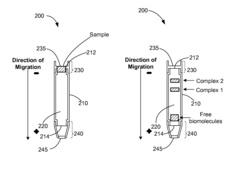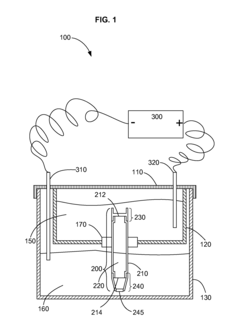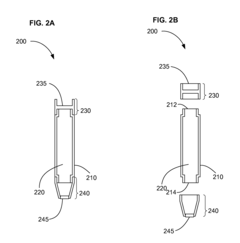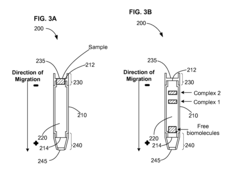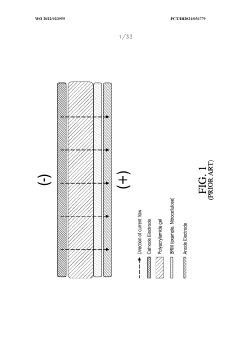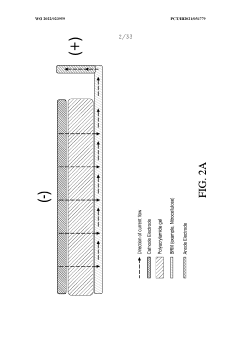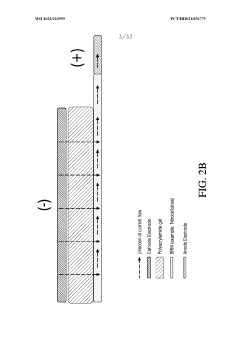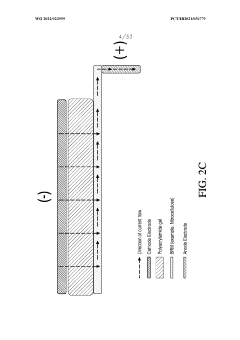How Does Gel Electrophoresis Enhance Biodiversity Studies?
JUN 30, 20259 MIN READ
Generate Your Research Report Instantly with AI Agent
Patsnap Eureka helps you evaluate technical feasibility & market potential.
Gel Electrophoresis in Biodiversity Research: Background and Objectives
Gel electrophoresis has emerged as a cornerstone technique in biodiversity studies, revolutionizing our ability to analyze and understand genetic diversity across species. This method, which separates DNA fragments based on their size and charge, has been instrumental in advancing our knowledge of evolutionary relationships, population genetics, and species identification.
The development of gel electrophoresis can be traced back to the 1930s, with significant advancements occurring in the 1950s and 1960s. Initially used for protein separation, its application to DNA analysis in the 1970s marked a turning point in molecular biology and genetics. As biodiversity research gained prominence in the late 20th century, gel electrophoresis became an indispensable tool for studying genetic variation within and between species.
The primary objective of employing gel electrophoresis in biodiversity studies is to provide a cost-effective and reliable method for genetic analysis. This technique allows researchers to visualize DNA fragments, enabling the identification of genetic markers, the detection of genetic variations, and the assessment of genetic diversity within populations.
One of the key advantages of gel electrophoresis in biodiversity research is its versatility. It can be applied to a wide range of organisms, from microorganisms to plants and animals, making it an invaluable tool for studying biodiversity across different ecosystems and taxonomic groups.
The technique has evolved significantly over the years, with advancements in gel materials, electrophoresis equipment, and DNA staining methods. These improvements have enhanced the resolution, sensitivity, and throughput of gel electrophoresis, allowing researchers to obtain more detailed genetic information from smaller sample sizes.
In the context of biodiversity studies, gel electrophoresis serves several critical functions. It enables the identification of species through DNA barcoding, facilitates the study of population genetics by revealing genetic polymorphisms, and aids in the reconstruction of phylogenetic relationships among species. These applications have profound implications for conservation biology, ecological research, and our understanding of evolutionary processes.
As we look to the future, the role of gel electrophoresis in biodiversity research continues to expand. Integration with other molecular techniques, such as PCR and DNA sequencing, has further enhanced its utility. The ongoing development of high-resolution gel systems and automated analysis tools promises to increase the efficiency and accuracy of biodiversity assessments, contributing to our ability to monitor and preserve global biodiversity in the face of environmental challenges.
The development of gel electrophoresis can be traced back to the 1930s, with significant advancements occurring in the 1950s and 1960s. Initially used for protein separation, its application to DNA analysis in the 1970s marked a turning point in molecular biology and genetics. As biodiversity research gained prominence in the late 20th century, gel electrophoresis became an indispensable tool for studying genetic variation within and between species.
The primary objective of employing gel electrophoresis in biodiversity studies is to provide a cost-effective and reliable method for genetic analysis. This technique allows researchers to visualize DNA fragments, enabling the identification of genetic markers, the detection of genetic variations, and the assessment of genetic diversity within populations.
One of the key advantages of gel electrophoresis in biodiversity research is its versatility. It can be applied to a wide range of organisms, from microorganisms to plants and animals, making it an invaluable tool for studying biodiversity across different ecosystems and taxonomic groups.
The technique has evolved significantly over the years, with advancements in gel materials, electrophoresis equipment, and DNA staining methods. These improvements have enhanced the resolution, sensitivity, and throughput of gel electrophoresis, allowing researchers to obtain more detailed genetic information from smaller sample sizes.
In the context of biodiversity studies, gel electrophoresis serves several critical functions. It enables the identification of species through DNA barcoding, facilitates the study of population genetics by revealing genetic polymorphisms, and aids in the reconstruction of phylogenetic relationships among species. These applications have profound implications for conservation biology, ecological research, and our understanding of evolutionary processes.
As we look to the future, the role of gel electrophoresis in biodiversity research continues to expand. Integration with other molecular techniques, such as PCR and DNA sequencing, has further enhanced its utility. The ongoing development of high-resolution gel systems and automated analysis tools promises to increase the efficiency and accuracy of biodiversity assessments, contributing to our ability to monitor and preserve global biodiversity in the face of environmental challenges.
Market Demand for Molecular Biodiversity Analysis Tools
The market demand for molecular biodiversity analysis tools has been experiencing significant growth in recent years, driven by the increasing importance of biodiversity conservation and the need for more accurate and efficient methods of species identification and population studies. Gel electrophoresis, as a fundamental technique in molecular biology, plays a crucial role in this expanding market.
The global biodiversity crisis has heightened the urgency for comprehensive and rapid assessment tools. This has led to a surge in demand for molecular techniques that can provide detailed genetic information about species and ecosystems. Gel electrophoresis, being a cost-effective and versatile method, is well-positioned to meet this growing need in both research and conservation efforts.
In the academic sector, universities and research institutions are major consumers of gel electrophoresis equipment and supplies for biodiversity studies. The technique is widely used in phylogenetic studies, population genetics, and species identification projects. As funding for biodiversity research increases globally, the market for these tools is expected to expand correspondingly.
Conservation organizations and government agencies represent another significant market segment. These entities require reliable and accessible methods for monitoring endangered species, detecting invasive organisms, and assessing ecosystem health. Gel electrophoresis provides a practical solution for these applications, driving demand in the public sector.
The biotechnology and pharmaceutical industries also contribute to the market demand, particularly in the context of bioprospecting and the development of new products based on biodiversity. These sectors utilize gel electrophoresis in the initial screening and characterization of genetic material from diverse biological sources.
Emerging markets in developing countries, especially those rich in biodiversity, are showing increased interest in molecular analysis tools. As these nations invest in building their research capacities and implementing conservation strategies, the demand for gel electrophoresis and related technologies is expected to rise significantly.
The market is further stimulated by technological advancements that enhance the capabilities of gel electrophoresis. Innovations such as automated systems, high-throughput platforms, and improved imaging technologies are making the technique more attractive to a broader range of users, including smaller laboratories and field researchers.
Despite the growing popularity of next-generation sequencing technologies, gel electrophoresis remains a staple in molecular biodiversity analysis due to its reliability, simplicity, and lower cost. This enduring relevance ensures a stable market demand, particularly in settings where advanced sequencing facilities are not readily available.
The global biodiversity crisis has heightened the urgency for comprehensive and rapid assessment tools. This has led to a surge in demand for molecular techniques that can provide detailed genetic information about species and ecosystems. Gel electrophoresis, being a cost-effective and versatile method, is well-positioned to meet this growing need in both research and conservation efforts.
In the academic sector, universities and research institutions are major consumers of gel electrophoresis equipment and supplies for biodiversity studies. The technique is widely used in phylogenetic studies, population genetics, and species identification projects. As funding for biodiversity research increases globally, the market for these tools is expected to expand correspondingly.
Conservation organizations and government agencies represent another significant market segment. These entities require reliable and accessible methods for monitoring endangered species, detecting invasive organisms, and assessing ecosystem health. Gel electrophoresis provides a practical solution for these applications, driving demand in the public sector.
The biotechnology and pharmaceutical industries also contribute to the market demand, particularly in the context of bioprospecting and the development of new products based on biodiversity. These sectors utilize gel electrophoresis in the initial screening and characterization of genetic material from diverse biological sources.
Emerging markets in developing countries, especially those rich in biodiversity, are showing increased interest in molecular analysis tools. As these nations invest in building their research capacities and implementing conservation strategies, the demand for gel electrophoresis and related technologies is expected to rise significantly.
The market is further stimulated by technological advancements that enhance the capabilities of gel electrophoresis. Innovations such as automated systems, high-throughput platforms, and improved imaging technologies are making the technique more attractive to a broader range of users, including smaller laboratories and field researchers.
Despite the growing popularity of next-generation sequencing technologies, gel electrophoresis remains a staple in molecular biodiversity analysis due to its reliability, simplicity, and lower cost. This enduring relevance ensures a stable market demand, particularly in settings where advanced sequencing facilities are not readily available.
Current State and Challenges in Gel Electrophoresis for Biodiversity Studies
Gel electrophoresis has become an indispensable tool in biodiversity studies, offering researchers a powerful method to analyze and differentiate genetic material from various species. Currently, this technique is widely used in molecular ecology, conservation genetics, and evolutionary biology to assess genetic diversity, identify species, and study population structures.
The current state of gel electrophoresis in biodiversity studies is characterized by its versatility and reliability. Researchers employ both agarose and polyacrylamide gels, depending on the size of DNA fragments they aim to separate. Agarose gels are commonly used for larger fragments, while polyacrylamide gels offer higher resolution for smaller DNA segments.
One of the primary applications of gel electrophoresis in biodiversity research is in DNA barcoding. This technique allows for the identification of species based on short genetic markers in an organism's DNA. By comparing these markers across different samples, researchers can accurately identify species and detect cryptic diversity that may not be apparent through morphological examination alone.
Another significant application is in population genetics studies. Gel electrophoresis enables researchers to analyze genetic variations within and between populations, providing insights into gene flow, genetic drift, and evolutionary processes. This information is crucial for understanding species' adaptations to different environments and for developing effective conservation strategies.
Despite its widespread use, gel electrophoresis faces several challenges in biodiversity studies. One of the main limitations is the resolution of closely related species or populations with minimal genetic differences. In such cases, more advanced techniques like capillary electrophoresis or next-generation sequencing may be required to detect subtle genetic variations.
Another challenge is the time-consuming nature of the technique, especially when dealing with large numbers of samples. This can be a significant bottleneck in large-scale biodiversity assessments. Efforts are being made to develop high-throughput systems that can process multiple samples simultaneously, but these are not yet widely available or cost-effective for many research labs.
The interpretation of gel electrophoresis results can also be challenging, particularly when dealing with complex mixtures of DNA from environmental samples. Contamination and the presence of inhibitors in environmental DNA can affect the quality of results, necessitating careful sample preparation and data analysis.
Furthermore, the technique's reliance on PCR amplification can introduce biases, especially when studying highly diverse communities. Some species may be over- or under-represented due to differences in DNA extraction efficiency or PCR amplification success rates. Researchers are working on developing more universal primers and optimizing protocols to minimize these biases.
As biodiversity studies increasingly focus on non-model organisms and complex ecosystems, there is a growing need for standardization of gel electrophoresis protocols across different taxa and sample types. This standardization would facilitate more accurate comparisons between studies and improve the reproducibility of results in biodiversity research.
The current state of gel electrophoresis in biodiversity studies is characterized by its versatility and reliability. Researchers employ both agarose and polyacrylamide gels, depending on the size of DNA fragments they aim to separate. Agarose gels are commonly used for larger fragments, while polyacrylamide gels offer higher resolution for smaller DNA segments.
One of the primary applications of gel electrophoresis in biodiversity research is in DNA barcoding. This technique allows for the identification of species based on short genetic markers in an organism's DNA. By comparing these markers across different samples, researchers can accurately identify species and detect cryptic diversity that may not be apparent through morphological examination alone.
Another significant application is in population genetics studies. Gel electrophoresis enables researchers to analyze genetic variations within and between populations, providing insights into gene flow, genetic drift, and evolutionary processes. This information is crucial for understanding species' adaptations to different environments and for developing effective conservation strategies.
Despite its widespread use, gel electrophoresis faces several challenges in biodiversity studies. One of the main limitations is the resolution of closely related species or populations with minimal genetic differences. In such cases, more advanced techniques like capillary electrophoresis or next-generation sequencing may be required to detect subtle genetic variations.
Another challenge is the time-consuming nature of the technique, especially when dealing with large numbers of samples. This can be a significant bottleneck in large-scale biodiversity assessments. Efforts are being made to develop high-throughput systems that can process multiple samples simultaneously, but these are not yet widely available or cost-effective for many research labs.
The interpretation of gel electrophoresis results can also be challenging, particularly when dealing with complex mixtures of DNA from environmental samples. Contamination and the presence of inhibitors in environmental DNA can affect the quality of results, necessitating careful sample preparation and data analysis.
Furthermore, the technique's reliance on PCR amplification can introduce biases, especially when studying highly diverse communities. Some species may be over- or under-represented due to differences in DNA extraction efficiency or PCR amplification success rates. Researchers are working on developing more universal primers and optimizing protocols to minimize these biases.
As biodiversity studies increasingly focus on non-model organisms and complex ecosystems, there is a growing need for standardization of gel electrophoresis protocols across different taxa and sample types. This standardization would facilitate more accurate comparisons between studies and improve the reproducibility of results in biodiversity research.
Existing Gel Electrophoresis Methods for Biodiversity Assessment
01 Improved gel composition for electrophoresis
Enhanced gel compositions for electrophoresis can be formulated using specific polymers, additives, or cross-linking agents. These improvements can lead to better separation of molecules, increased resolution, and improved overall performance of the gel electrophoresis process.- Improved gel composition: Enhanced gel compositions for electrophoresis can be formulated using specific polymers, additives, or cross-linking agents. These improvements can lead to better resolution, faster separation, and increased stability of the gel matrix. Some formulations may include temperature-responsive polymers or novel cross-linking methods to optimize gel performance.
- Advanced buffer systems: Developing specialized buffer systems can significantly enhance gel electrophoresis performance. These buffers may include additives that improve sample migration, reduce background noise, or maintain optimal pH conditions throughout the separation process. Some buffer formulations may also incorporate components that enhance staining or visualization of separated molecules.
- Electrode and power supply innovations: Advancements in electrode design and power supply systems can lead to more efficient and consistent gel electrophoresis. These innovations may include pulsed field systems, programmable power supplies, or electrode materials that reduce electrolysis effects. Some designs focus on miniaturization or integration with other analytical techniques.
- Sample preparation and loading techniques: Improved methods for sample preparation and loading can enhance the overall performance of gel electrophoresis. These techniques may include novel sample concentration methods, automated loading systems, or strategies to reduce sample degradation. Some approaches focus on increasing the amount of sample that can be loaded without compromising resolution.
- Detection and analysis enhancements: Advancements in detection and analysis methods can significantly improve the utility of gel electrophoresis. These enhancements may include novel staining techniques, integrated imaging systems, or software for automated band analysis. Some approaches focus on increasing sensitivity or enabling real-time monitoring of the separation process.
02 Advanced electrode design and materials
Innovations in electrode design and materials can significantly enhance gel electrophoresis performance. This includes the use of novel electrode materials, optimized electrode configurations, and improved electrode coatings to increase conductivity and reduce interference.Expand Specific Solutions03 Buffer system optimization
Optimizing buffer systems can enhance gel electrophoresis by improving separation efficiency, reducing background noise, and increasing the overall resolution of the separated molecules. This may involve the use of novel buffer compositions or adjusting buffer concentrations and pH levels.Expand Specific Solutions04 Integration of detection and imaging technologies
Incorporating advanced detection and imaging technologies into gel electrophoresis systems can enhance the visualization and analysis of separated molecules. This may include fluorescence-based detection methods, high-resolution imaging systems, or real-time monitoring capabilities.Expand Specific Solutions05 Miniaturization and automation of gel electrophoresis systems
Developing miniaturized and automated gel electrophoresis systems can enhance throughput, reduce sample consumption, and improve overall efficiency. This includes the design of microfluidic devices, lab-on-a-chip systems, and automated sample loading and analysis platforms.Expand Specific Solutions
Key Players in Gel Electrophoresis and Biodiversity Analysis
Gel electrophoresis has become a crucial tool in enhancing biodiversity studies, with the market for this technology experiencing steady growth. The industry is in a mature phase, with established players like Life Technologies Corp. and Agilent Technologies, Inc. leading the way. The global market size for gel electrophoresis is estimated to be in the billions of dollars, driven by increasing applications in genomics and proteomics research. Technologically, gel electrophoresis has reached a high level of maturity, with ongoing innovations focusing on improving resolution, speed, and automation. Companies like Applied Biosystems LLC and Beckman Coulter, Inc. continue to refine their offerings, while academic institutions such as the University of Bath contribute to advancing the technique's capabilities in biodiversity research.
Life Technologies Corp.
Technical Solution: Life Technologies, now part of Thermo Fisher Scientific, has developed the E-Gel electrophoresis system, which uses pre-cast agarose gels for rapid and convenient DNA and RNA analysis[10]. This system is particularly useful in biodiversity studies for its ability to quickly process multiple samples with minimal hands-on time. The company's E-Gel Power Snap Electrophoresis System integrates real-time visualization of DNA separation, allowing researchers to monitor and capture results in real-time[11]. Life Technologies also offers the Attune NxT Flow Cytometer, which, while not a gel electrophoresis system, complements biodiversity studies by enabling rapid analysis of cell populations and sorting of microbial communities[12]. These technologies collectively enhance the efficiency and depth of biodiversity assessments across various ecosystems.
Strengths: User-friendly, rapid results, and minimal sample preparation. Weaknesses: Limited customization options compared to traditional gel electrophoresis, may not be suitable for all types of samples.
Beckman Coulter, Inc.
Technical Solution: Beckman Coulter has developed the ProteomeLab PA 800 system, which utilizes capillary electrophoresis for high-resolution protein and nucleic acid analysis[7]. This technology is particularly valuable in biodiversity studies for its ability to separate and characterize complex mixtures of biomolecules from diverse organisms. The system's laser-induced fluorescence detection allows for highly sensitive analysis of genetic markers and protein profiles[8]. Beckman Coulter also offers the GenomeLab GeXP Genetic Analysis System, which combines capillary electrophoresis with multiplex PCR for gene expression profiling[9]. This technology enables researchers to simultaneously analyze multiple genetic markers across different species, providing a comprehensive view of genetic diversity within ecosystems.
Strengths: High sensitivity and multiplexing capabilities, suitable for both genetic and proteomic analyses. Weaknesses: Complex setup and operation, may require specialized expertise for data interpretation.
Innovations in Gel Electrophoresis for Species Identification
Method for the purification of biological macromolecules
PatentInactiveUS20110011742A1
Innovation
- The method involves loading a sample containing free biomolecules and complexes onto an electrophoresis gel, applying an electric current to separate the free biomolecules from the complexes, and then reversing the current direction to collect the complexes of interest, using a semi-permeable membrane to retain the biomolecules of interest, thus masking inhomogeneity and concentrating them for analysis.
Electrotransfer & electrophoresis devices, systems, & methods
PatentWO2022023959A1
Innovation
- A single system for gel electrophoresis, electrotransfer, and detection that includes a device with a biomolecule receiving material and electrodes arranged to allow current flow in multiple directions, enabling efficient transfer and detection of biomolecules with reduced buffer volumes and hazardous waste, and improved antibody recognition.
Environmental Impact of Gel Electrophoresis in Biodiversity Studies
Gel electrophoresis, a widely used technique in biodiversity studies, has both positive and negative environmental impacts. On the positive side, this method enables researchers to analyze genetic material with high precision, contributing to a deeper understanding of biodiversity and ecosystem health. By providing accurate data on species identification and population genetics, gel electrophoresis supports conservation efforts and helps in monitoring endangered species.
However, the environmental impact of gel electrophoresis in biodiversity studies is not without concerns. The process involves the use of various chemicals, including acrylamide, which is a neurotoxin and potential carcinogen. Improper disposal of these chemicals can lead to soil and water contamination, potentially harming local ecosystems. Additionally, the production and disposal of plastic consumables used in the process contribute to plastic waste, a growing environmental issue.
The energy consumption associated with running gel electrophoresis equipment is another environmental consideration. While individual experiments may not consume significant amounts of electricity, the cumulative effect of numerous studies conducted worldwide can contribute to increased carbon emissions, particularly if the energy source is not renewable.
Field sampling for biodiversity studies involving gel electrophoresis may also have localized environmental impacts. The collection of specimens, especially in sensitive ecosystems, can disrupt habitats and potentially stress local populations if not conducted with care. However, these impacts are generally minimal when proper sampling protocols are followed.
On a broader scale, the application of gel electrophoresis in biodiversity studies has indirect positive environmental effects. The knowledge gained from these studies informs conservation strategies, helps in the development of sustainable resource management practices, and contributes to policy decisions that protect ecosystems. This long-term benefit to environmental preservation often outweighs the immediate, localized impacts of the technique.
As environmental awareness grows, efforts are being made to mitigate the negative impacts of gel electrophoresis. These include the development of more environmentally friendly reagents, improved waste management protocols, and the exploration of alternative techniques that may have less environmental impact while providing similar or better results in biodiversity studies.
However, the environmental impact of gel electrophoresis in biodiversity studies is not without concerns. The process involves the use of various chemicals, including acrylamide, which is a neurotoxin and potential carcinogen. Improper disposal of these chemicals can lead to soil and water contamination, potentially harming local ecosystems. Additionally, the production and disposal of plastic consumables used in the process contribute to plastic waste, a growing environmental issue.
The energy consumption associated with running gel electrophoresis equipment is another environmental consideration. While individual experiments may not consume significant amounts of electricity, the cumulative effect of numerous studies conducted worldwide can contribute to increased carbon emissions, particularly if the energy source is not renewable.
Field sampling for biodiversity studies involving gel electrophoresis may also have localized environmental impacts. The collection of specimens, especially in sensitive ecosystems, can disrupt habitats and potentially stress local populations if not conducted with care. However, these impacts are generally minimal when proper sampling protocols are followed.
On a broader scale, the application of gel electrophoresis in biodiversity studies has indirect positive environmental effects. The knowledge gained from these studies informs conservation strategies, helps in the development of sustainable resource management practices, and contributes to policy decisions that protect ecosystems. This long-term benefit to environmental preservation often outweighs the immediate, localized impacts of the technique.
As environmental awareness grows, efforts are being made to mitigate the negative impacts of gel electrophoresis. These include the development of more environmentally friendly reagents, improved waste management protocols, and the exploration of alternative techniques that may have less environmental impact while providing similar or better results in biodiversity studies.
Data Management and Bioinformatics in Gel-Based Biodiversity Research
The integration of data management and bioinformatics tools has revolutionized gel-based biodiversity research, significantly enhancing the efficiency and accuracy of data analysis. As gel electrophoresis continues to play a crucial role in biodiversity studies, the need for robust data management systems and advanced bioinformatics approaches has become increasingly apparent.
Modern data management systems in gel-based biodiversity research typically incorporate specialized software for image analysis, band detection, and molecular weight estimation. These systems enable researchers to digitize gel images, automatically detect and quantify bands, and store this information in structured databases. Such digitization not only facilitates easier data sharing and collaboration but also allows for more sophisticated downstream analyses.
Bioinformatics tools have greatly expanded the analytical capabilities of gel-based biodiversity studies. Sequence alignment algorithms, for instance, can be applied to compare band patterns across multiple samples, enabling rapid identification of species or genetic variants. Phylogenetic analysis software can then use this data to construct evolutionary trees, providing insights into the relationships between different organisms or populations.
Machine learning algorithms are increasingly being employed to improve the accuracy of band detection and classification, particularly in complex gel patterns. These algorithms can be trained on large datasets to recognize subtle differences in band intensity and position, potentially uncovering patterns that might be missed by human observers.
Database integration is another critical aspect of bioinformatics in gel-based biodiversity research. By linking gel electrophoresis data with other molecular data types, such as DNA sequences or protein structures, researchers can gain a more comprehensive understanding of biodiversity. This integration often involves the use of standardized data formats and ontologies to ensure interoperability between different data sources and analysis tools.
Cloud-based platforms are emerging as powerful solutions for managing and analyzing gel electrophoresis data in biodiversity studies. These platforms offer scalable storage and computing resources, enabling researchers to process large datasets and run complex analyses that might be impractical on local systems. Additionally, cloud platforms facilitate collaborative research by providing shared access to data and analysis tools across geographically dispersed teams.
As the volume and complexity of biodiversity data continue to grow, the development of more sophisticated data management and bioinformatics tools remains an active area of research. Future advancements may include the integration of artificial intelligence for automated species identification from gel patterns, the development of standardized workflows for reproducible analysis, and the creation of global databases linking gel electrophoresis data to broader biodiversity information systems.
Modern data management systems in gel-based biodiversity research typically incorporate specialized software for image analysis, band detection, and molecular weight estimation. These systems enable researchers to digitize gel images, automatically detect and quantify bands, and store this information in structured databases. Such digitization not only facilitates easier data sharing and collaboration but also allows for more sophisticated downstream analyses.
Bioinformatics tools have greatly expanded the analytical capabilities of gel-based biodiversity studies. Sequence alignment algorithms, for instance, can be applied to compare band patterns across multiple samples, enabling rapid identification of species or genetic variants. Phylogenetic analysis software can then use this data to construct evolutionary trees, providing insights into the relationships between different organisms or populations.
Machine learning algorithms are increasingly being employed to improve the accuracy of band detection and classification, particularly in complex gel patterns. These algorithms can be trained on large datasets to recognize subtle differences in band intensity and position, potentially uncovering patterns that might be missed by human observers.
Database integration is another critical aspect of bioinformatics in gel-based biodiversity research. By linking gel electrophoresis data with other molecular data types, such as DNA sequences or protein structures, researchers can gain a more comprehensive understanding of biodiversity. This integration often involves the use of standardized data formats and ontologies to ensure interoperability between different data sources and analysis tools.
Cloud-based platforms are emerging as powerful solutions for managing and analyzing gel electrophoresis data in biodiversity studies. These platforms offer scalable storage and computing resources, enabling researchers to process large datasets and run complex analyses that might be impractical on local systems. Additionally, cloud platforms facilitate collaborative research by providing shared access to data and analysis tools across geographically dispersed teams.
As the volume and complexity of biodiversity data continue to grow, the development of more sophisticated data management and bioinformatics tools remains an active area of research. Future advancements may include the integration of artificial intelligence for automated species identification from gel patterns, the development of standardized workflows for reproducible analysis, and the creation of global databases linking gel electrophoresis data to broader biodiversity information systems.
Unlock deeper insights with Patsnap Eureka Quick Research — get a full tech report to explore trends and direct your research. Try now!
Generate Your Research Report Instantly with AI Agent
Supercharge your innovation with Patsnap Eureka AI Agent Platform!
